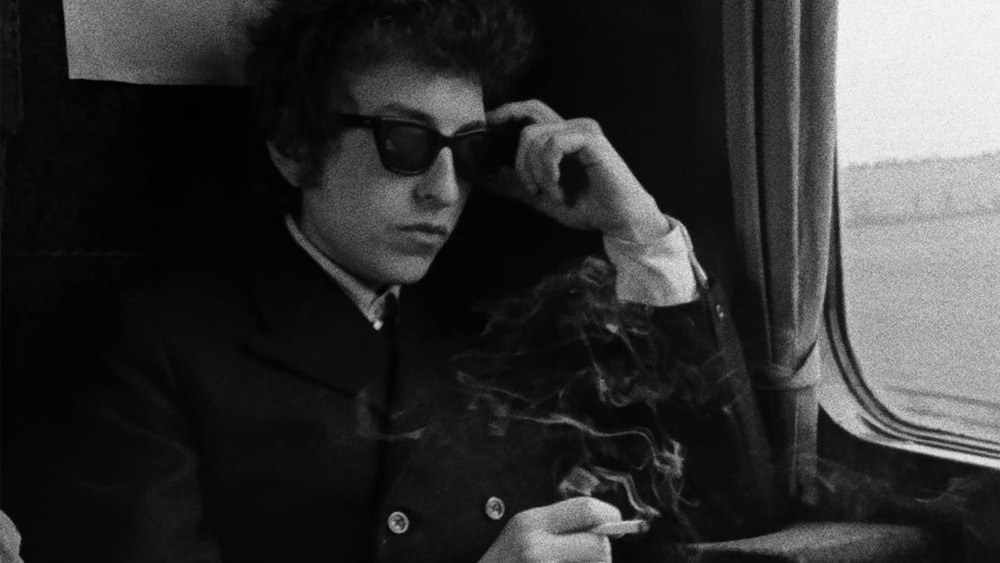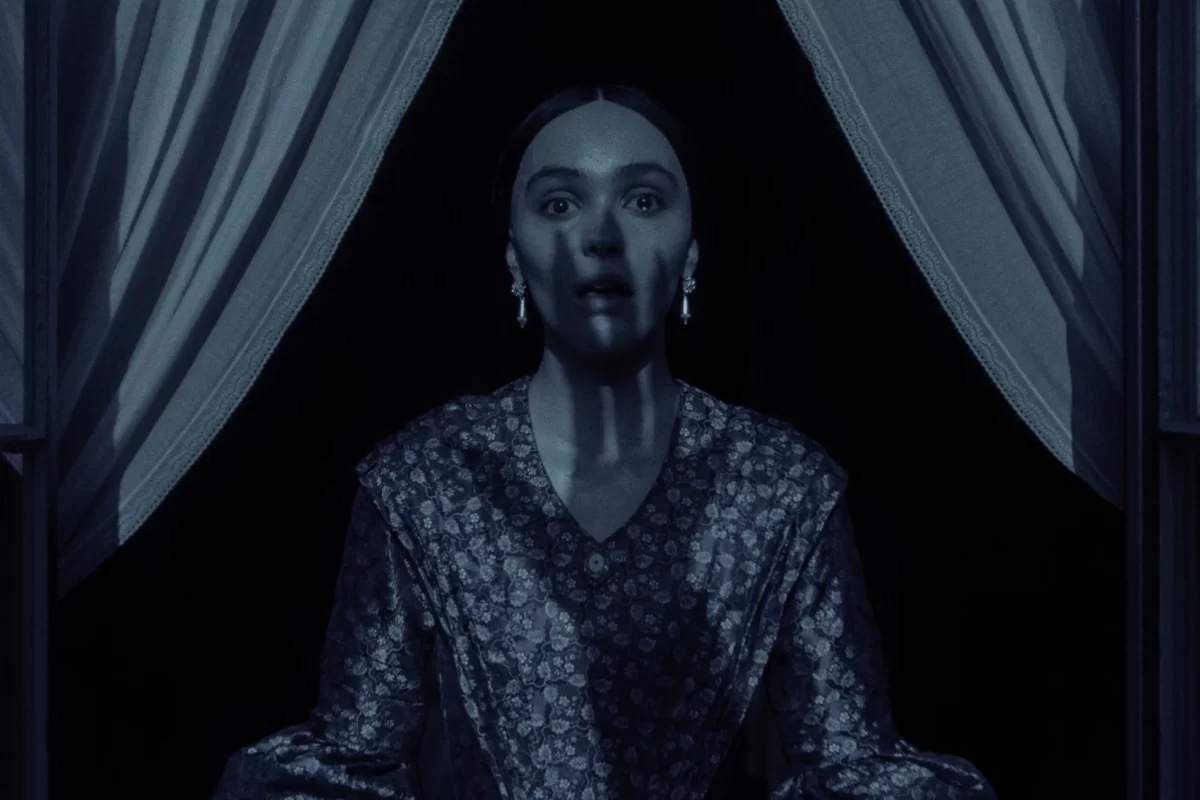By Matthew Dodd
‘I didn’t consciously pursue the Bob Dylan myth, it was given to me–by God’, Bob Dylan told People Magazine in 1975. And yet, despite his best efforts, he remains the centre of a vast cultural legendarium encompassing university modules, murals in North London suburbs, street names in rural Minnesota and almost everything in between. He is, perhaps, the most documented, revered, critiqued, impersonated and mythologised musical figure of the last century. It’s no surprise then that he should also receive the 21st century’s favourite tribute to the giants of recent history: an Oscar-tipped Hollywood biopic. James Mangold’s A Complete Unknown, starring Timothee Chalamet in the lead role, depicts the life of the young Dylan arriving in New York and builds towards his infamous decision to ‘go electric’ at the 1965 Newport Folk Festival. Yet, despite being the first major biopic of Dylan, A Complete Unknown is far from the Nobel laureate’s first foray into the world of cinema. The Coen Brothers’ Greenwich Village fable Inside Llewyn Davis only features Dylan – or a version of Dylan – for a few seconds near the end but is nevertheless a beautiful evocation of the time and place which gave rise to his legend and an ode to the music that made him. More obviously, Todd Haynes’ 2007 film I’m Not There sees six actors – including Heath Ledger, Cate Blanchett and Marcus Carl Franklin – playing different sides of Dylan’s persona, offering a kaleidoscopic view of this most multifaceted of figures. Still, however, no effort to capture Bob Dylan on film has been so singularly powerful, so essential to understanding the artist, as the very earliest: D.A. Pennebaker’s 1967 documentary Don’t Look Back. Recorded over the course of Dylan’s 1965 tour of Britain, Don’t Look Back offers an unceremonious and impromptu insight into a man who, before our very eyes, is being transformed into a myth.
As the film opens, we find our hero flanked by his team, shuffling through an airport interchange, ruminating on whether he’s allowed to smoke indoors and singing a nursery rhyme to himself. The genius of Pennebaker’s film is that he doesn’t approach his subject as though he were the most significant artist of his generation, but rather as though he were a 24-year-old college dropout with a talent for being supremely obnoxious. Coincidentally, this is exactly who Dylan was. Over the course of the film, we are presented with the dichotomous visions of Bob Dylan, a pop culture sensation who is shaking the very foundations of contemporary music, and Bob Dylan, a man. Between these warring images we almost find some granule of sincere truth about both figures. Through the window of a London phone box we watch as a middle-aged critic sends back a review of Dylan’s concert line by line, fearing that the audience ‘applaud the songs and miss, perhaps, the sermon.’ This insistence from the press that there must be something more to Dylan’s music, a serious literary value that couldn’t possibly be understood by lank haired teenagers, dogs the film. In response to every suggestion of genius, or even intent, Dylan obfuscates – ‘I don’t write for any reason’, he tells a Time magazine reporter before sounding off a polemical diatribe about the inherent phoniness of the mainstream press. The film looks on from afar at the active mythmaking put upon this young songwriter by the world around him. It argues, instead, that genius is happening largely by accident in little, unmajestical ways. While sitting improvising over an unfinished song, Dylan casually throws in a lyric, ‘I’m a rolling stone’. This line of improvisation does not lead him anywhere before the film’s end.
Other moments speak more overtly to the developing sense that this young star might just be something special. In the back of a car, Dylan hears about a British folk artist, a young man named Donovan, and insists on meeting him. This meeting, documented in full, sees the pair perform songs to one another. Donovan plays a sweet but unremarkable rendition of ‘To Sing for You’, to which Bob jovially responds ‘Hey, that’s a good song, man!’ before bringing the room to an awed silence with ‘It’s All Over Now Bay Blue’. The gap between these two artists, even at this stage, appears cavernous. For all his cocksure posturing, there is an acceptance that Bob Dylan is, by the age of 24, already an important artist. With the benefit of 50 years’ retrospect, the film now seems morosely vindicated. The artists who surround him, such as Donovan and the Animals’ Alan Price, have not quite faded into obscurity, but have certainly become footnotes in the grand narrative of Bob Dylan.
One major character whose legend has survived the Dylan monolith is his friend, on-and-off lover and creative partner Joan Baez – another of the folk movement’s most iconic figures. She first appears here making faces at the camera and doing mock accents before explaining to a reporter – who takes her as simply another element of Dylan’s cavalcade – how to spell her name. By the ‘Z’ of ‘Baez’, the reporter realises his mistake, jolting back with a peculiarly British ‘Oh strewth! I’ve been looking for you all day.’ The relationship between Dylan and Baez is perhaps one of greatest mysteries in the history of folk music, and one of the most beloved points of discussion amongst self-proclaimed Dylanologists, but it comes out here as nothing so nebulous, more so a casual intercourse between two young people drawn together into a massive and unknowable world of cameras, reporters and sold-out music halls. In the back of a car, she sings a deformed version of ‘Baby Blue’, ‘crying like a banana in the sun’. She uniquely refers to Dylan as ‘Bobby’, sticking out as quite possibly the only person in the film who doesn’t view him as a prophet, financial prospect or spoiled brat. Through this narrow window into the lives of two musical titans, we see them quite simply as tender friends.
Walking hand in hand with the development of Dylan the myth is the administration of Dylan the business. Long scenes are dedicated to Dylan’s manager attempting to squeeze as much money out of record executives as possible, the name ‘Bob Dylan’ becoming a byword for riches. Later, Bob and co. quibble over the position of ‘Subterranean Homesick Blues’ in the charts – a meagre number 16 at first. These scenes are a bold reminder that the pursuit of art is not always one run on good will alone. The cultivation of this ‘voice of a generation’ was an opportunity to make a great deal of money, a fact that Don’t Look Back finds no shame in acknowledging. It is the banal, ugly and crass moments that Pennebaker chooses to spend his time on which makes Don’t Look Back such a singularly powerful accomplishment. It is a rare documentary which seems genuinely interested in revealing something about who its subject is, rather than trying to place them into an imposed narrative of success. We watch Dylan perform to sold out venues, but we also watch him, perhaps even more closely, as he awkwardly re-tunes his guitar after ‘The Times They Are A-Changing.’ This is a portrait of the artist unscripted, unceremonious and unpolished.
The central limitation of the biopic in its current form is its futile desire to aggrandise its subject to legendary status, mapping a hero’s journey onto the life of a real human being. Perhaps the most egregious example of this in recent memory is Bryan Singer’s 2018 film Bohemian Rhapsody. Instead of painting an intimate picture of one of the most iconic rock bands of all time, Singer’s film insists on transforming Queen’s career into a three-act tragedy and Freddie Mercury into its tragic hero. His homosexuality is treated as hamartia, his exploration of his sexuality as the pit of his moral degradation. It cannot go unnoticed that this film was made with the express supervision of the band’s surviving members – no wonder, perhaps, that one of the film’s climactic scenes see Freddie apologise at length to the rest of the band for his errant behaviour. This style of biopic turns people into caricatures and, as in Bohemian Rhapsody’s case, risks imposing prejudicial readings onto real lives. All too frequently, these films turn some of the most exciting figures of our time into obnoxious burlesques of their public persona, with every moment of their lives steeped in some sort of divine knowledge of their own greatness. How many times must we watch a biopic tell us just how important every aspect of an artist’s life is in leading them to write one of a dozen or so popular hits? Perhaps the sorry state of the music biopic was best diagnosed by the 2007 satire Walk Hard: the Dewey Cox Story, in which the fictional folk/rock/pop star’s drummer tells crowds ‘Dewey Cox has to think about his entire life before he plays!’
This is not to say that the biopic is a doomed genre altogether, recent offerings such as last year’s Oppenheimer and Priscilla are proof of that, but there is a sense in which the best examples are those which do not propose to be an authoritative biographical extravaganza but rather a reading of a life. Often, these films work best as a synthesis of artist and subject: Oppenheimer may be read as a film as much about Christopher Nolan’s own guilt of creation as his protagonist’s, Priscillia as a story not unlike Sofia Coppola’s own as a young girl forced to meet all too early the scrutiny of the public eye. But fundamentally, they are all simply versions of the story: recollections, urban legends, re-translations of ancient manuscripts.
A Complete Unknown may be a wonderful film about a young songwriter who changed the world, but he will be Bob Dylan the myth rather than Robert Zimmerman the man. It will tell us how this boy became the voice of his generation; how he, with little more than a guitar, a funny haircut and a polyamorous spirit, revolutionised popular music. But it will not give us, across two hours, any of the same insight into who this most elusive of artists actually was as D.A. Pennebaker does when he captures Dylan laughing at the British pronunciation of ‘bloke’, throwing a tantrum at his harmonica being out of tune or, most crucially, instructing his rowdy posse to ‘be groovy or leave, man.’ Bob Dylan has always been a figure who revels in indefinability. Throughout his life he has rejected classification as a folk singer, protest singer, poet, anarchist, and most every other moniker thrown at him. A Complete Unknown will try its best to define him again as one thing or another – voice of a generation, genius, asshole etc. – but, in Don’t Look Back, Dylan himself put all such definitions to rest in perpetuity, telling student journalist Terry Ellis, quite simply, that ‘I’m just a guitar player. That’s all.’
Image credit: The Criterion Collection




